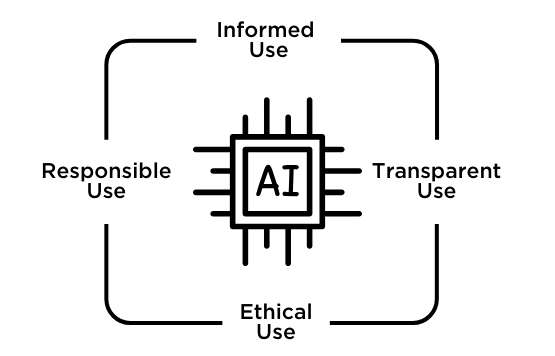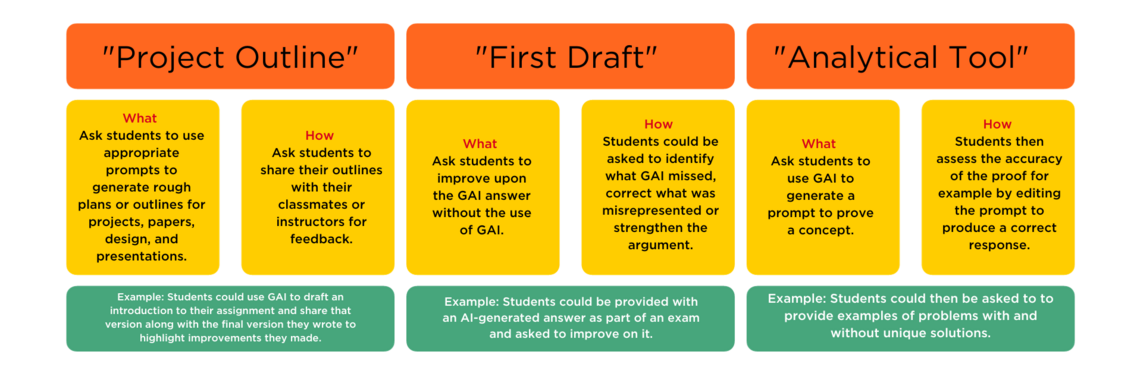The way digital technologies are designed, used, and presented in the public discourse have implications for teacher assessment practices, as they potentially transform how the teachers grade students' work and consider what assessment entails in the new technological landscape.
Farazouli et al., 2023, p.4
This short guide provides some context on Generative Artificial Intelligence for instructors, as well as some suggestions for ethically addressing artificial intelligence in teaching and learning. There are also some risks and limitations you may need to consider as well as some guiding questions and approaches which may help mitigate those risks and limitations.
Ethical Artificial Intelligence Literacy

Informed Use: Prior to using the tool, research who or what company developed the tool, how it was developed, how it works, what functions it can perform, and what limitations and/or risks it presents.
Transparent Use: In your work, indicate in detail and expressly which tool you used and how you used it.
Ethical Use: The manuscripts must distinguish what was written or produced directly by you and what was generated by an AI tool.
Responsible Use: Limit the use of AI tools to early stages of research, to inspire or suggest directions, not to produce content that will later be included in your deliverables. In any use of GAI, it is your responsibility to verify all content.
Gutiérrez, J. (2023) Guidelines for the Use of Artificial Intelligence in University Courses. Version 4.3, Universidad del Rosario.
Possible limitations and risks of Generative AI use
AI systems may not fit into your teaching and may be problematic. The following are some factors to consider when deciding whether to incorporate AI in your assessments:
Mitigating the limitations and risks of Generative AI use
Possible uses of AI in assessments

Cornell University Center for Teaching and Innovation (2023). Generative Artificial Intelligence for Education and Pedagogy. https://teaching.cornell.edu/generative-artificial-intelligence/cu-committee-report-generative-artificial-intelligence-education?mibextid=hubsqH
Developing artificial intelligence literacy
Guiding Questions
Incorporating GAI into assessments can offer benefits and challenges for both instructors and students. Here are some guiding questions for instructors to think about when considering the use of GAI in their assessments:
- What are the specific learning outcomes or goals that I want students to achieve with this assessment? How can Generative AI help me better align the assessment with these objectives?
- What type of assessment am I planning to use AI for? Which aspect of the assessment will Generative AI enhance or automate?
- How will I ensure fairness and avoid bias in Generative AI assessments? Have I considered potential biases in the training data or AI algorithms? What steps can I take to mitigate bias and ensure fairness in the assessment process?
- How will students be informed about the use of Generative AI in assessments? Are there any ethical or privacy concerns that students should be aware of?
- How will I ensure the ethical and responsible use of Generative AI in assessments? Have I considered the ethical implications if using Generative AI in grading or assessments?
- How can GAI enhance the feedback process for students? Can Generative AI help in making feedback timelier and more accurate?
- How will I assess the effectiveness of Generative AI in improving assessments? Will I conduct surveys or gather feedback from students?
References and resources
Cornell University Center for Teaching and Innovation (2023). Generative Artificial Intelligence for Education and Pedagogy. https://teaching.cornell.edu/generative-artificial-intelligence/cu-committee-report-generative-artificial-intelligence-education?mibextid=hubsqH
Farazouli, A., Cerratto-Pargman, T., Bolander Laksov, K., & McGrath, C. (2023). Hello GPT! Goodbye home examination? An exploratory study of AI chatbots impact on university teachers’ assessment practices. Assessment and Evaluation in Higher Education. https://doi.org/10.1080/02602938.2023.2241676
Gutiérrez, J. (2023) Guidelines for the Use of Artificial Intelligence in University Courses. Version 4.3, Universidad del Rosario. https://forogpp.files.wordpress.com/2023/02/guidelines-for-the-use-of-artificial-intelligence-in-university-courses-v4.3.pdf
Mishra, P., Warr, M. & Islam, R. (2023). TPACK in the age of ChatGPT and Generative AI, Journal of Digital Learning in Teacher Education, 39(4), 235-251. https://doi.org/10.1080/21532974.2023.2247480
National Academic Integrity Network (2023). Generative artificial intelligence guidelines for educators. https://www.qqi.ie/what-we-do/engagement-insights-and-knowledge-sharing/national-academic-integrity-network




